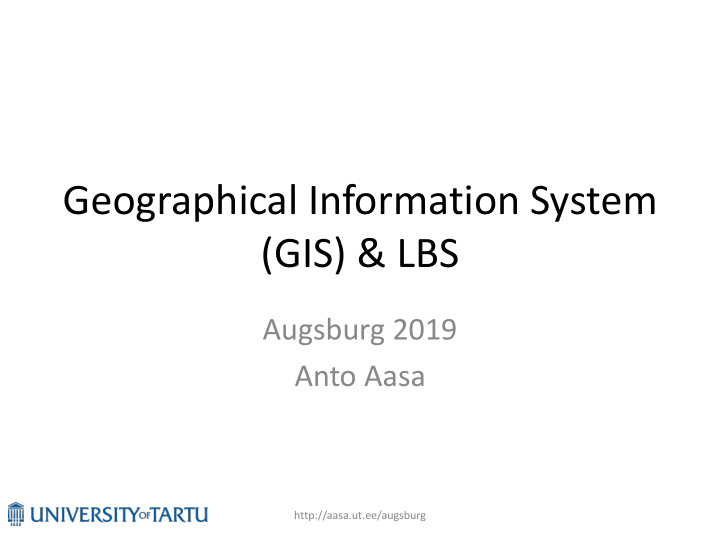



Geographical Information System (GIS) & LBS Augsburg 2019 Anto Aasa http://aasa.ut.ee/augsburg
Important factors for LBS • Location • Spatial data & GIS • Wireless communication • Positioning – Satellite – Mobile phone – Indoor (WLAN, RFID) • Functioning of LBS (location only is not the LBS) http://aasa.ut.ee/augsburg
• Everything, what happends in real world has geographical coordinates – X – Y – Z – time • (also in virtual space) http://aasa.ut.ee/augsburg
Location • Map and database must be in same coordinate system and datum – Surface of the earth • Land • Sea – Geoid – Ellipsoid http://aasa.ut.ee/augsburg
Location: • Describing • Spatial • Network http://aasa.ut.ee/augsburg
Spatial databases & GIS • Location: spatial vs describing? – N 48° 21’ 17’’ E 11 ° 47’ 15’’ – Germany, Munich airport • Relation between points => distances – Geography in general!!! http://aasa.ut.ee/augsburg
Geographic information system (GIS) • Mutually related complex of software and data – Watching geographical information, – Administration of geographical information, – Analysis of spatial relationships and patterns, – Modelling of spatial processes. http://aasa.ut.ee/augsburg
GIS • Hardware • Software • Database – Geographical space – Theme (attributes) • Operations • Human resource – Knowledge – Experience • … http://aasa.ut.ee/augsburg
GIS functions • Mapping and visualization; • administration of geographical information; • data collecting and updating; • geographical analysis. http://aasa.ut.ee/augsburg
History • First person who placed different layers on top of each other? http://aasa.ut.ee/augsburg
Cholera deaths in London John Snow 1854 http://aasa.ut.ee/augsburg
http://aasa.ut.ee/augsburg
History • 1963: first nation-wide GIS - Canada • 1966: first raster-GIS • 1972: first civil use remote sensing satellite Landsat 1 • 1978: first satellites of NAVSTAR (development of GPS technology) • 1979: first vector-GIS – ODYSSEY GIS • 1981: Esri ARC/INFO • 1986: MapInfo – first desktop GIS • 1994: beginning of standardization of spatial data and infrastructure (OpenGIS consortium) • 1996: first Internet based GIS products • 1996: first Internet based map service MapQuest • 2000: over 1 million professional GIS users in world, over 5 million „ average “ GIS users • 2016: starts GNSS Galileo http://aasa.ut.ee/augsburg
Area of use • Land survey, cartography • Logistics • Aviation • Real estate • Military forces • Trade • Local authority • Science • Infrastructure management • … • Location Based Services http://aasa.ut.ee/augsburg
Representation of spatial data • Real world is too complex • Simplified models – Maps – Cartography http://aasa.ut.ee/augsburg
Modelling of the real world • Discrete objects • Continuous fields Visualization of invisible objects ( Augmented, Mixed Reality) http://aasa.ut.ee/augsburg
Representation of geoinformation in GIS • objects (set of points, lines and polygons); • raster; • attributes. http://aasa.ut.ee/augsburg
Point Vector Line Polygon http://aasa.ut.ee/augsburg
Raster ortophoto Landuse concentration slope Elevation shading Population density http://aasa.ut.ee/augsburg
• Attributes table: – Rows: map objects – Columns: attributes – Queries http://aasa.ut.ee/augsburg
• Layer based model: – One theme for every layer – One data type for every layer (point, line, polygon, raster) Elevation http://aasa.ut.ee/augsburg
GIS resolution Model vs visualization http://aasa.ut.ee/augsburg http://nas-sites.org/climatemodeling/page_3_2.php
• Use of color – Traditions of visualising certain object types • Symbols • Colors http://aasa.ut.ee/augsburg
• Map scale – the ratio of a distance on the map to the corresponding distance on the ground (e.g. 1:400 000) • Generalization – Simplifying of objects Measurements accuracy Model accuracy Amount of data http://aasa.ut.ee/augsburg
Generalization http://aasa.ut.ee/augsburg
GIS output • Table • Graph • Report • Thematic map • Something else? What is the aim? Mobile device display! http://aasa.ut.ee/augsburg
Internet maps • Different API’s for LBS: – Open Street Map – Google Map – Bing Map • WMS • … http://aasa.ut.ee/augsburg
• Earth is not ideal sphere but geoid (potato- shaped) – Earth model: ellipsoid • Map projection – method of representing the surface of Earth on a plane – All map projections distort the surface in some fashion • Error minimization http://aasa.ut.ee/augsburg
Distortions – area, – direction, – scale, – distance. http://aasa.ut.ee/augsburg
Creating GIS • Reality model (description of the real world) • Data model (database structure and technology) • Representation model (rules for data representation) – e.g. Roads on top of rivers http://aasa.ut.ee/augsburg
Management of spatial data • Raster model – Rectangular regular grid of pixels • Vector model – Points, lines, polygons (functions determining the shape and form of objects) http://aasa.ut.ee/augsburg
Processing of geographical data • Processing of the initial data for achievement of goals – Queries (response to relevant conditions) – Spatial analysis (description of place, attribues and relationships between them) http://aasa.ut.ee/augsburg
Quality of spatial data • Completeness (missing, redundant data) • Consistence • Location correctness • Up-to-date • Thematic correctness http://aasa.ut.ee/augsburg
For tomorrow • How to visualize flow in time and space? • Movement of parcel • Data download http://aasa.ut.ee/augsburg
Recommend
More recommend